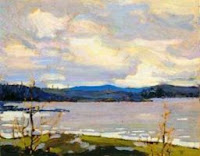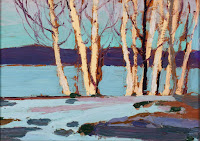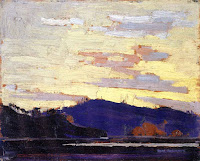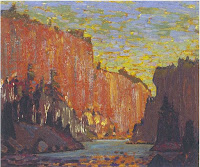 |
Thomas John Thomson (born 5 August 1877 in Claremont, ON; died 8 July 1917, almost 40 years old ) circa 1905–10. |
Thoreau MacDonald (1901-1989), the son of JEH MacDonald of the Group of Seven, was also a friend of Tom, and he wrote:
“Thomson’s work would be a fine study for some competent critic, but anyone attempting it should be familiar, not only with every phase of his work but with the country too, lakes, rivers, weather; have them in his bones … “
I prefer to be positive... being critical is not my style, but my natural science background brings fresh information to the Tom Thomson catalogue raisonné. This project will take some years to complete, but I am in no rush.
In the draft of my "Tom Thomson Was A Weatherman" book, I included several chapters describing the meteorology and natural science employed to better understand his art. This information has already been written in "The Art and Science of Phil the Forecaster" blogs, which I have been compiling for many years. If you should encounter a term or concept that I do not adequately explain within the context of a particular Thomson work, a search of this site will certainly yield the answers. I will typically include linked references to the required background information with each painting.
The following is a list of the Blog entries to date, accompanied by a representative image and a linked title to the Blog. Some paintings require more than one blog post to fully explain. Tom accurately painted the truth of what he saw.
Arthur Lismer, his friend and Group of Seven member, described Thomson as someone who "sought the wilderness, never seeking to tame it, but only to draw from it, its magic of tangle and season." That wilderness put the "wild" into his art.
Blodwen Davies included in the 1967 publication "Tom Thomson: The Story of a Man Who Looked for Beauty and for Truth In The Wilderness" that Tom Thomson had remarked: "Someday they will know what I mean." Hopefully, that day has arrived.
Note: Miss Blodwen Davies's passed in 1966, but she had previously sought help from Group of Seven artist A. Y. Jackson, who had written the Foreword to the first self-published version in 1935. That first printing was limited to 100 copies, and the 1967 republished version of that scarce book is available to a larger audience.
Thank you for your interest. These posts have been a lifetime in coming.
Tom Thomson Was A WeathermanThunderhead: Pink Cloud over a Lake - Summer 1916
Tom Thomson's Black Spruce Autumn 1915 observation of a cold frontal passage
Tom Thomson's Clouds (The Zeppelins) of an approaching warm front with heavy snow and conditional symmetric instability at 8 pm on Thursday, April 29th, 1915 - Astronomy
Tom Thomson's Afternoon: Algonquin Park, 1915 Studio Work in The Shack - Tom painted this in late November 1914 and one of his last works in the Studio Building before heading to the Shack.
Northern Lights 1915. The flip side of Smoke Lake - Summer 1915. Tom observed and recorded space weather as well.
Spring in Algonquin Park, 1917. A lot of weather...
Canoe Lake Spring, 1917 - an afternoon sketch with the centre of the low-pressure area nearby turns into much more with the assistance of Roy MacGregor
Birches, 1917 - and the story is not about the trees.
Lowery Dickson's Cabin 1917. Daphne was wearing the white hat but the meteorology is even more interesting.
The Rapids Spring 1917
Spring Break-up Spring 1917
Northern Lake, Early Winter Spring 1917
Early Spring Alternate title: Spring Ice and Birches Spring 1917
Early Spring, Canoe Lake Spring 1917
Winter Thaw Spring 1917
Autumn Clouds Fall 1915 Dynamic cloud shaped by the wind bathed in the light of sunset tell an intriguing story of science and the weather.
Evening Cloud Alternate titles: Evening Clouds; Storm Cloud; Storm Clouds Fall 1915 Hers is the real story... cumulus congestus at a cold frontal passage wearing the Belt of Venus...
Artist's Camp, Canoe Lake, Algonquin Park Alternate title: Night Camp Fall 1915. There is a very interesting story behind the white "balloon silk", state-of-the-art tent.
Algonquin Park, Spring 1916. There is a lot of science in this small panel... and we can even guess where Thomson was sitting.
Birches, 1916 The sky was the real star of this painting.
Spring Break-up, 1916 The underlying story is of a clear-cut forest with nothing to hold back the spring floods. The cracks in the shoreline ice hold those clues.
Portage, Ragged Lake Spring 1915 This is a story of icy swirls. Tea-stained ice pans swirling in the turbulent waters of the outflow from Ragged Lake during the spring flood.
The Sketch for the Jack Pine 1916. Imagine a solitary tree exposed on the rocky shore of a northern lake facing the elements alone. Simply staying alive was a victory. Thomson captured that iconic message in oils. "The Jack Pine" has become the metaphoric touchstone of the Canadian experience. Like the seeds of a torched Jack Pine, Thomson's art could only be sown after his death to inspire the next generation of artists. Little Cauchon Lake, Spring 1916 A story from the fishing trip of late April 1916. TT-134


Autumn, Petawawa, Fall 1916 (1916.94) TT-Post 142

Autumn, Algonquin Park 1916 TT-Post 105Lake in Autumn Alternate titles: Late Afternoon?; Swamp in Fall? Fall 1916 TT-Post 106Canoe Lake, Algonquin Park Fall 1916 TT-Post 107Pink Clouds Fall 1916 TT-Post 108Wild Geese: Sketch for "Chill November" Alternate titles: First Snow Ducks; Sketch for "Chill November" Fall 1916 TT-Post 109Sunset, Canoe Lake Fall 1916 TT-Post 110
 |
| Tom Thomson May 1917 at the campsite firepit. The last picture of Tom that I am aware of... |
Warmest regards and keep your paddle in the water,
Phil the Forecaster Chadwick
PS: I once corresponded with Ross King, the author of "Defiant Spirits" and he believes that the "ancient question of St. Hilary of Poitiers—“Who can look on nature and not see God? ”—can be given a Canadian twist. Who can look on nature and not see Tom Thomson?" That phrase does indeed sum up the art and science of Tom Thomson.












































































































































3 comments:
This is brilliant,phil!!! Love it!barbara harry
Thank you so very much, Barbara and Harry... This project has been in the works for decades. Surprisingly, it takes some significant effort to translate the book into blogs. With encouragement like yours, I will make it happen. Thanks!
Thank you for the very good and useful article. You can refer to it.wall paintings
Post a Comment